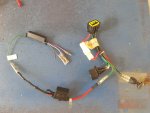Texasmark
Supreme Mariner
- Joined
- Dec 20, 2005
- Messages
- 14,880
Still not fixed but I have made progress. I had so far been looking at the Seloc Manual because it has a more complete wiring diagram however, it made it look like the tacho module is at the gauge end. The Mercury Manual only shows it in the test procedure but makes it look part of the loom so I went looking and found it at the motor end under the fuse cover.
once I found it I was able to conduct the test procedure which passed. I did a continuity test on the gray wire at the motor to the back of the gauge and it doesn’t appear to have any breaks in it. Because I couldn’t think of anything else I plugged the generic gauge straight into the module at the motor and run power straight to the board with no luck (the needle on both gauges make a small movement down when power is turned on).
while the batteries have been charging I did check the voltage while on charge more closely and it was at 14.5v. The test procedure for the regulator rectifier says to replace the regulator if the output is 14.5 to 15.0 volts so I guess I’ll replace that as well.
Does the regulator / rectifier out putting 14.5v indicate any problems?
Voltage from running the engine starts being recorded at 1000 RPMs and increases to WOT...in the manual. At WOT with a full battery, a non regulated alternator will put out up to 16ish volts while a regulated one will be up to 14.5v. I used Seloc and Merc OEM manuals on my last engine and did find Seloc to fill in some blanks left by the OEM manual.
Before you plunk down cash for a regulator look up the RPM vs voltage output in the manual and remember this is for a battery with a reasonable charge, keeping the amperes within the specified 9-16 Amperes rating for your particular engine.
Tachs can croak. My last boat was a 2002 and the Merc tach was working fine. Current boat is also a 2002, Merc, and the Farina tach had croaked. They do fail. You need 3 things for it to work so ensure that you have all 3...(Ignition) switched power, (Red/Purple stripe, or Purple), Ground (Black) and Tach Input (Grey). The other wire (Green?) is for your light bulb.























